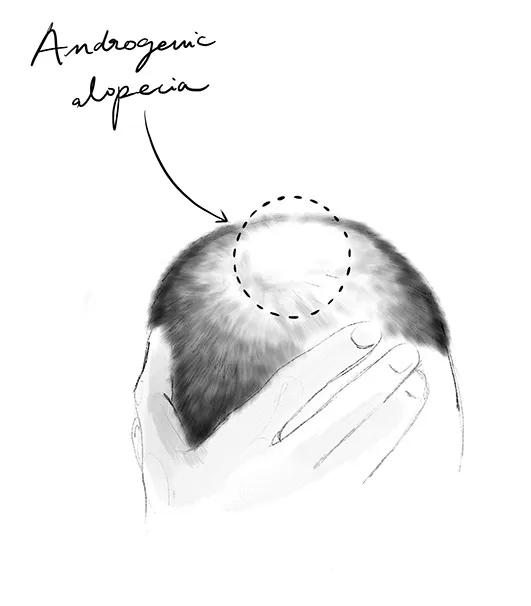Androgenetic Alopecia Male
"Androgenetic alopecia male is a common form of hair loss that affects men. It is also known as male pattern baldness and is characterized by hair loss at the temples and crown of the head. Androgenetic alopecia male is caused by genetic sensitivity to androgens, which are male hormones like testosterone. These androgens can shrink the hair follicles and make the hair thinner and weaker, eventually leading to its loss."

Mateo, 35 years old
Solution for Androgenetic Alopecia Male
Mateo started losing his hair ten years ago. Being so young, he thought it was due to stress or a temporary situation. But the problem worsened, and he lost hair in the top area, becoming bald. Finding solutions was not easy either: the hair transplant treatments he saw on TV didn't convince Mateo, and other options like hairpieces or standard wigs were not compatible with his life as an athlete because the adhesive would come off. So he decided to visit a specialized center, where they explained all the options he had and showed him the hair integration systems from Integral Hair.
Hair loss at the temples and crown in men
Mateo suffered from androgenetic alopecia male and was looking for the best solution. Seeing that the result was natural and of high quality, Mateo decided to give it a try, and we designed a Partial Integration System for him. We used organic short hair that allowed the stylist to create a short and modern hairstyle, as Mateo liked.
To continue enjoying sports as always, we opted for the hair bonding technique, which allows the hair system to be fused to his scalp using a special hypoallergenic liquid adhesive, ensuring a strong fixation.
It is a procedure similar to what is also done in cases of frontal fibrosing alopecia. Mateo feels better than ever now and lives his life as an athlete to the fullest. To take care of his hair, he visits his professional center every four to six weeks.
-
Frequently Asked Questions about Androgenetic Alopecia Male
-
Is Mateo's case real?
The case we present of Mateo is not real. It is an avatar or fictional case that illustrates the situation of thousands of users who find themselves in the same situation.
-
History of Androgenetic Alopecia Male
Androgenetic Alopecia Male dates back to ancient times, but its scientific understanding began in the 1940s when its relationship with androgens was discovered. Since then, there have been advances in the diagnosis and treatment of this common condition that affects many men worldwide.
-
How does Androgenetic Alopecia progress Male?
Androgenetic Alopecia Male gradually progresses over time. It usually starts with a decrease in hair thickness and density at the temples and crown. As it progresses, the hair becomes thinner and more easily falls out. In some cases, Androgenetic Alopecia Male can lead to complete or partial baldness. The rate and severity of hair loss can vary for each individual based on their genetic, hormonal, and health history.
-
Who does Androgenetic Alopecia Male affect?
Androgenetic Alopecia Male mainly affects men of all ages, although it is more common in those who have a family history of the condition. It can also be triggered by factors such as stress, poor nutrition, certain medications, and underlying medical conditions. Androgenetic Alopecia Male is one of the most common forms of hair loss in men.
-
What is the origin of Androgenetic Alopecia Male?
Androgenetic Alopecia Male is caused by genetic sensitivity to androgens, especially dihydrotestosterone (DHT), a male hormone. Androgens can shrink hair follicles and make the hair thinner and weaker, ultimately leading to its loss. Genetic predisposition plays a significant role in the onset of this condition.
-
What are the treatments and solutions for Androgenetic Alopecia Male?
There are several treatments for Androgenetic Alopecia Male, such as oral and topical medications that reduce DHT production or stimulate hair growth. In cases that require a more permanent solution, a hair integration system is advised, or hair transplants are also an option. Additionally, lifestyle changes such as a healthy diet and stress management can help prevent the progression of the condition.
-
What cosmetic solutions does the hair industry offer to restore the thinned area during the progression of Androgenetic Alopecia Male?
The hair industry offers temporary cosmetic solutions such as wigs, extensions, scalp makeup, and treatments to restore the thinned area during Androgenetic Alopecia Male . It is important to consult with a specialist to determine the best option. However, it is recommended to explore more permanent treatment options to address the condition at its root and slow down the progression of hair loss.
-
Can dermatological treatments for Androgenetic Alopecia Male be combined with the use of Integration Systems?
The combination of dermatological treatments with hair integration systems is a viable option for treating Androgenetic Alopecia Male . Many patients choose to use both services to improve their appearance and self-esteem. It is important for dermatology and trichology specialists to work together with experts in hair integration systems to provide personalized solutions to each patient based on their stage of alopecia.
-
Can hair transplantation solve Androgenetic Alopecia Male?
Yes, hair transplantation can solve Androgenetic Alopecia Male by transferring hair resistant to DHT from the donor area to the affected area. The effectiveness of the transplant depends on various factors, including age, severity of alopecia, and the skill of the surgeon.
< back